The 2024 Washington Summit marked the 75th anniversary of the North Atlantic Treaty Organization (NATO) by celebrating the Alliance’s enduring commitment to the transatlantic region’s freedom and security. Yet despite paeans to the North Atlantic Treaty’s Article 5—which states that an attack on one member is an attack on all—national leaders have proven reticent about commitment, rhetorical and practical, to Article 3, which requires that NATO members “maintain and develop their individual and collective capacity to resist armed attack.”REF
Ever since the 1952 Lisbon Force Goals, a lively conversation has taken place within NATO about the level of forces required for deterrence and, therefore, what amount of defense spending is necessary for deterrence. Starting with guidance emerging from the 2006 NATO Defense Minister’s meeting, member countries have aimed to spend 2 percent of gross domestic product (GDP) annually on defenseREF—but many have not done so. The 2014 Wales Summit reaffirmed this guidance by restating the 2 percent standard for all NATO countries and reinforcing an expectation that they would also spend at least 20 percent of their defense budgets “on major equipment, including related Research & Development.”REF
The Wales Summit Declaration arrived as the rose-tinted view of post–Cold War peace fractured. The fracture arose through actions like Russia’s occupation and seizure of Crimea, ISIS’s terror-fueled emergence, and North African political instability. Confronted by these factors, NATO spending has nevertheless risen slowly, with only 23 of 32 NATO countries meeting the 2 percent spending target a decade later despite Putin’s second invasion of Ukraine. The yawning gulf between NATO members’ spending and the Wales Summit’s spending targets over the past decade demonstrates why America calls on NATO members to spend more.
Today’s Threat Environment Demands More
While cashing in a peace dividend after the Berlin Wall fell bridged the continental transition to free markets and democracy, NATO defense spending plummeted across the Alliance, leaving nations unprepared to confront a deteriorating threat environment. For example, the Chinese Communist Party presents a pacing challenge to America while also threatening stability worldwide. From threatening to invade Taiwan and crater the global economyREF to supporting Russia’s invasion of UkraineREF and ties to the brutal Iranian regime,REF Beijing’s actions threaten NATO members’ security and welfare.
Alongside their Chinese patron, Russia and Iran continue to actively perpetuate hot conflicts. Russia has invaded Ukraine,REF tangled with Baltic Sea energy and communications infrastructure,REF militarized its Arctic icebreaker program,REF deployed Wagner forces in Africa, and provided targeting support to Houthi terrorists.REF (To say nothing of Russia’s no-limits partnership with China.) Meanwhile, Iran stands on the precipice of a nuclear weapons breakout on Europe’s doorstepREF as its arms industry grows through drone sales to Russia.REF The following section illustrates the levels of spending across NATO compared to the 2 percent minimum target set in the 2014 Wales Declaration.
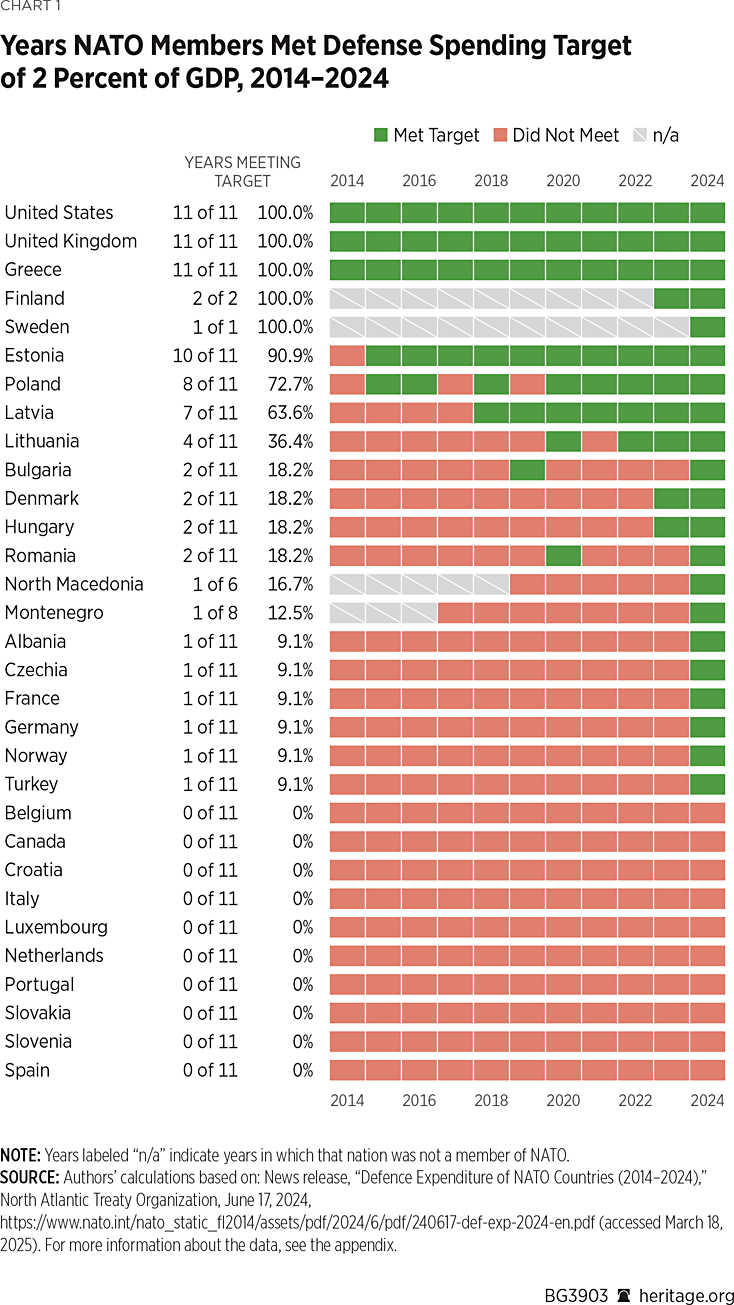
NATO Spending from 2014 to 2024
When reviewing NATO’s collective defense resources, the data presented in Chart 1 paints a stark picture of drastically unequal investment in collective defense. Since the 2014 Wales Summit, where all members reaffirmed their commitment to spending at least 2 percent of GDP on defense, the vast majority failed to meet this minimum until last year. In fact, while the majority of NATO members finally reached the threshold in 2024, NATO members over the past decade averaged only 1.59 percent. (See Chart 2.)
However, careful analysis reveals striking geographic disparities. While Eastern European nations—particularly Poland and the Baltic states—have prioritized defense spending in response to Russia’s aggression, Western European countries continue to lag behind. Despite Russa’s 2014 annexation of Crimea, many of NATO’s wealthiest members ignored the spending target for nearly a decade. Now, as the Ukraine war enters its third year and the strategic risks to European NATO territory intensify, continued underfunding by key members is no longer sustainable.
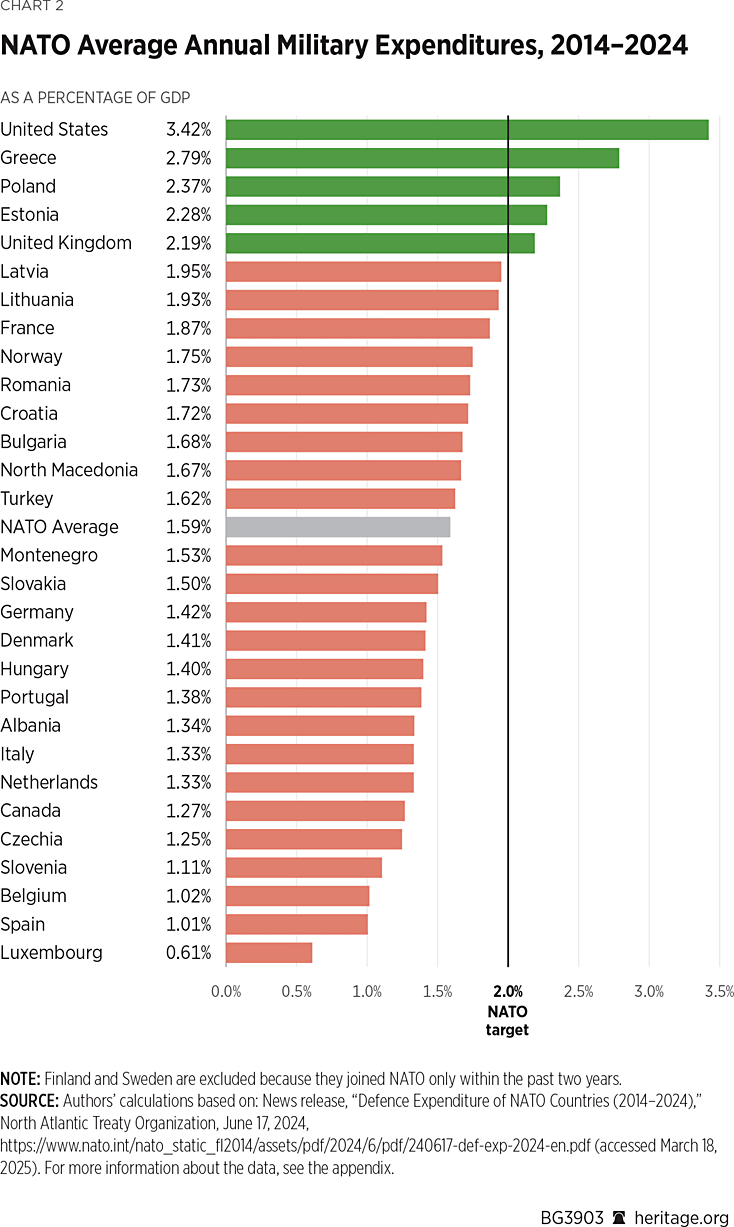
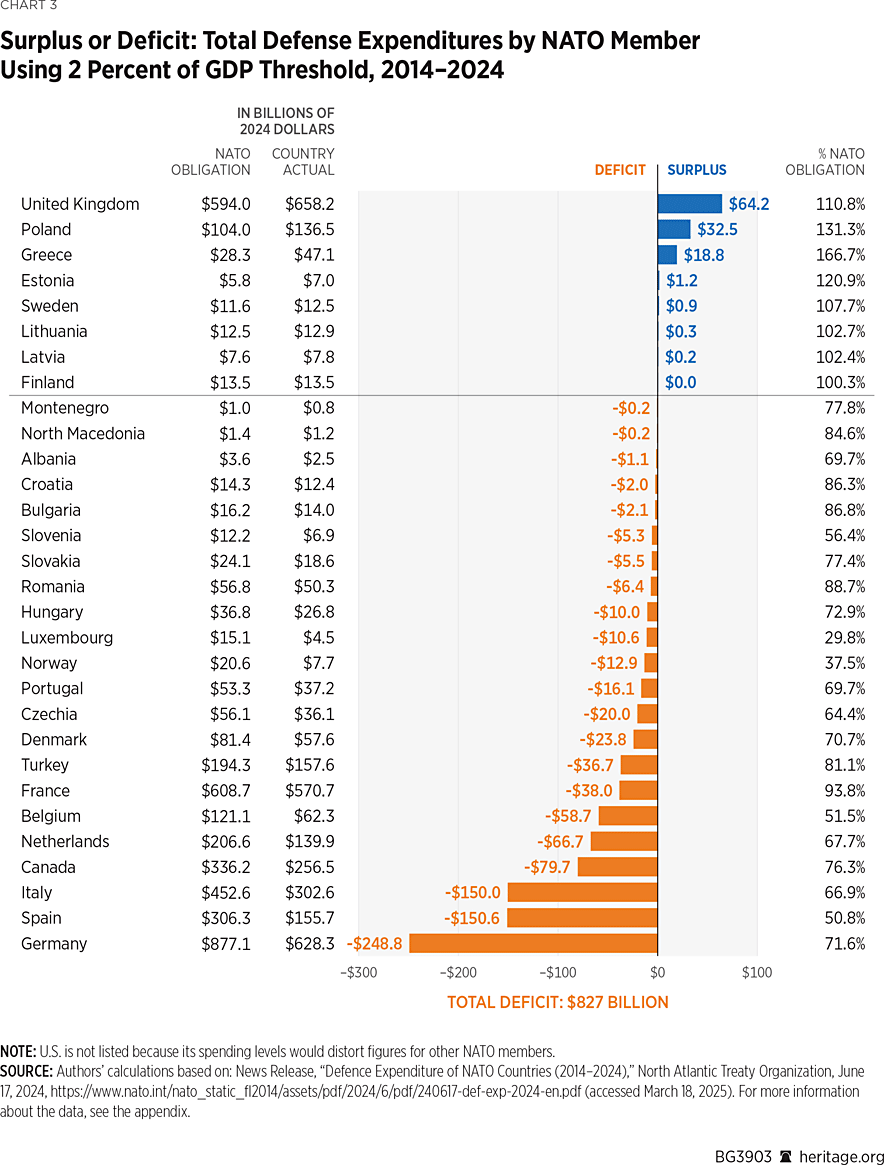
When breaking down cumulative spending shortfalls, the magnitude of NATO’s underinvestment becomes undeniable. Chart 3 highlights that many members have remained between 25 percent and 50 percent below the minimum spending benchmark over the past decade. In 2024 dollars, these shortfalls translate into massive real-world deficits:
- Germany: $249 billion below 2 percent
- Italy: $150 billion below 2 percent
- Spain: $150 billion below 2 percent
- Canada: $80 billion below 2 percent
- Netherlands: $67 billion below 2 percent
- Belgium: $60 billion below 2 percent
In total, America’s NATO allies have collectively underfunded their own defense by $827 billion since 2014, adjusted to 2024 dollars. To put this into perspective, this cumulative shortfall is nearly equal to the entire annual defense budget of the United States.REF This fact is why American policymakers continue to express frustration when European NATO members dismiss spending figures as an outdated or arbitrary metric.REF While some European officials argue that NATO should shift its focus from spending percentages to capability-based contributions, the reality is simple: Capabilities cannot be developed or iterated upon without sustained investment. NATO member states must spend on capabilities as outlined by NATO’s Strategic Concept and Regional Defense Plans, or those plans are nothing more than empty vision-casting without expenditures.REF
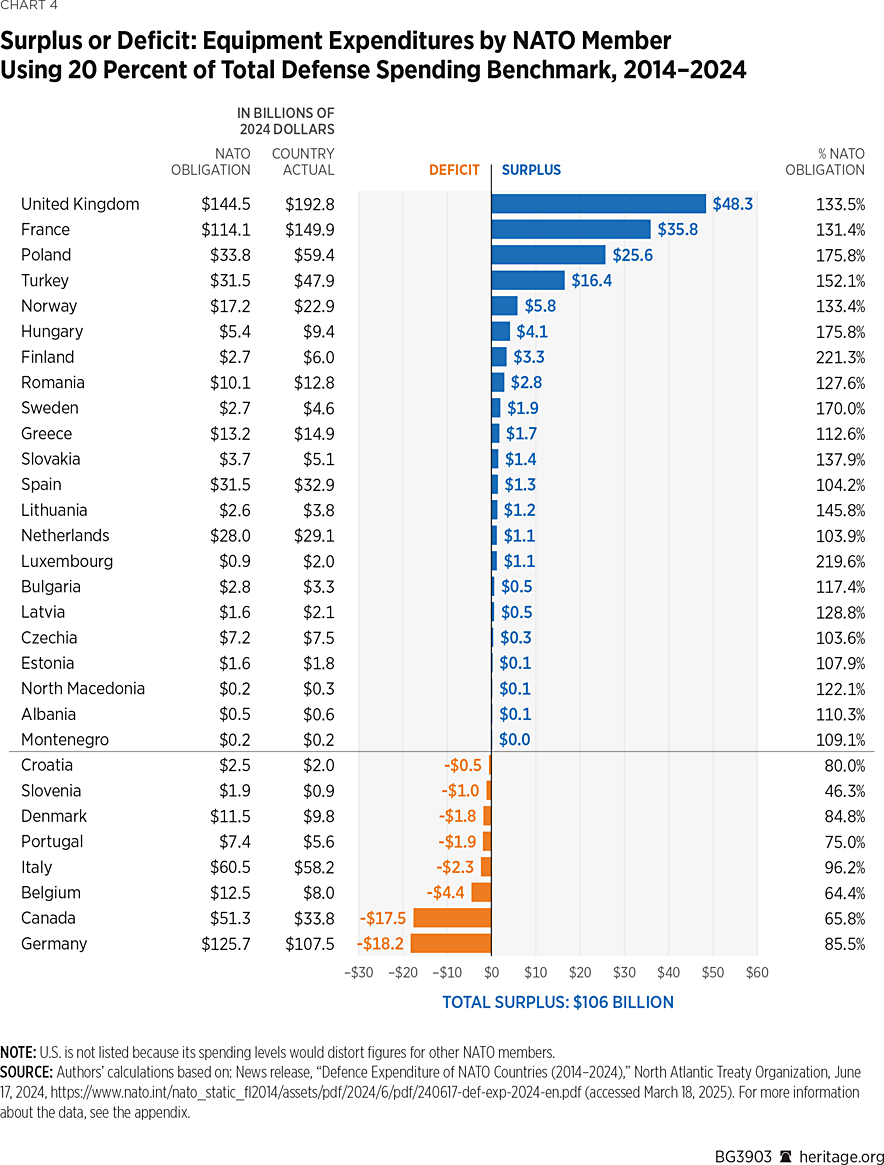
Notwithstanding years of rearmament discussion, NATO members have attempted to claim a net surplus of $106 billion in military equipment (in 2024 dollars) between 2014 and 2024, as shown in Chart 4. While technically accurate based on the definitions outlined in the 2014 Wales Declaration, this claim is misleading.
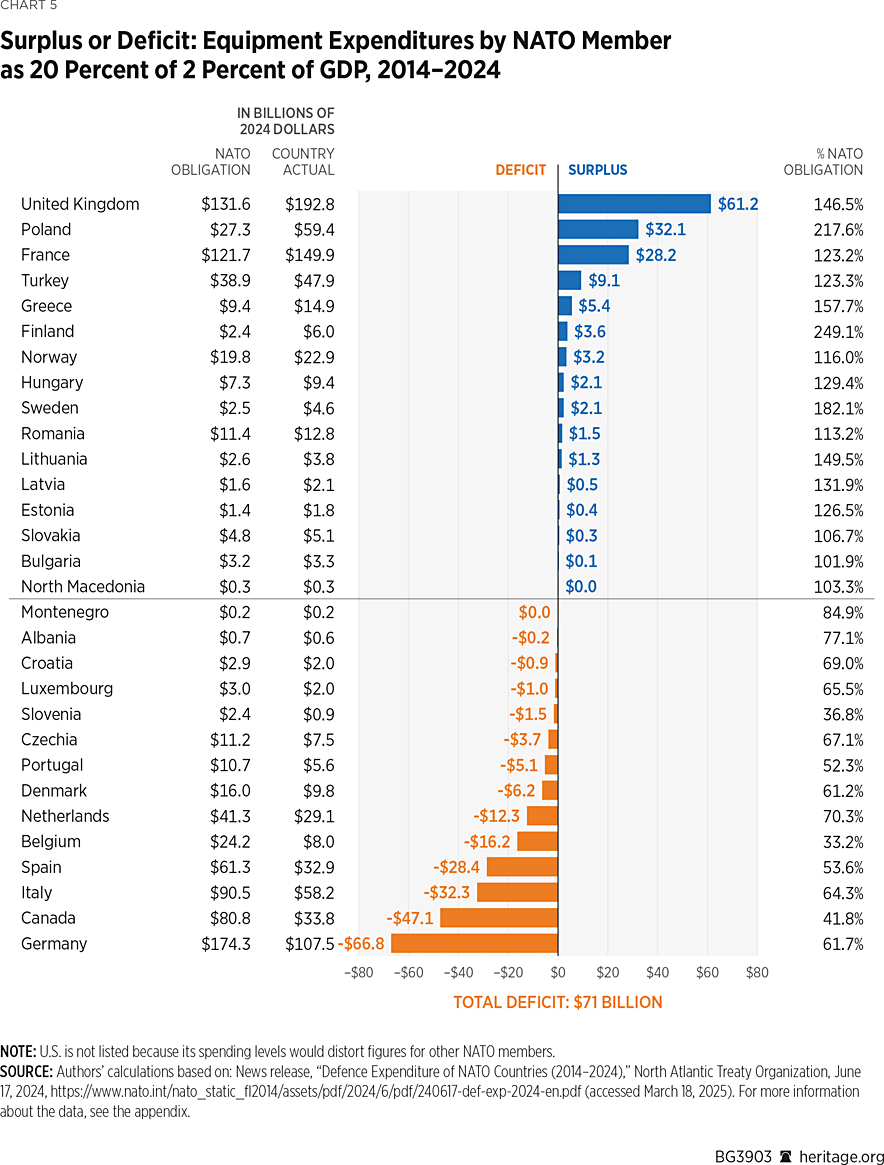
While many members achieved their 20 percent equipment spending target, their total defense budgets were below their 2 percent of GDP commitment, meaning that their overall defense investment remains insufficient to close key capability gaps.
Chart 5 illustrates this issue. When adjusting for the 2 percent minimum threshold, NATO’s collective equipment deficit since 2014 stands at $71 billion. This funding gap represents critical shortfalls in armored formations, long-range artillery platforms, air defense systems, ammunition stores, and logistics infrastructure—all of which are essential to NATO deterrence.
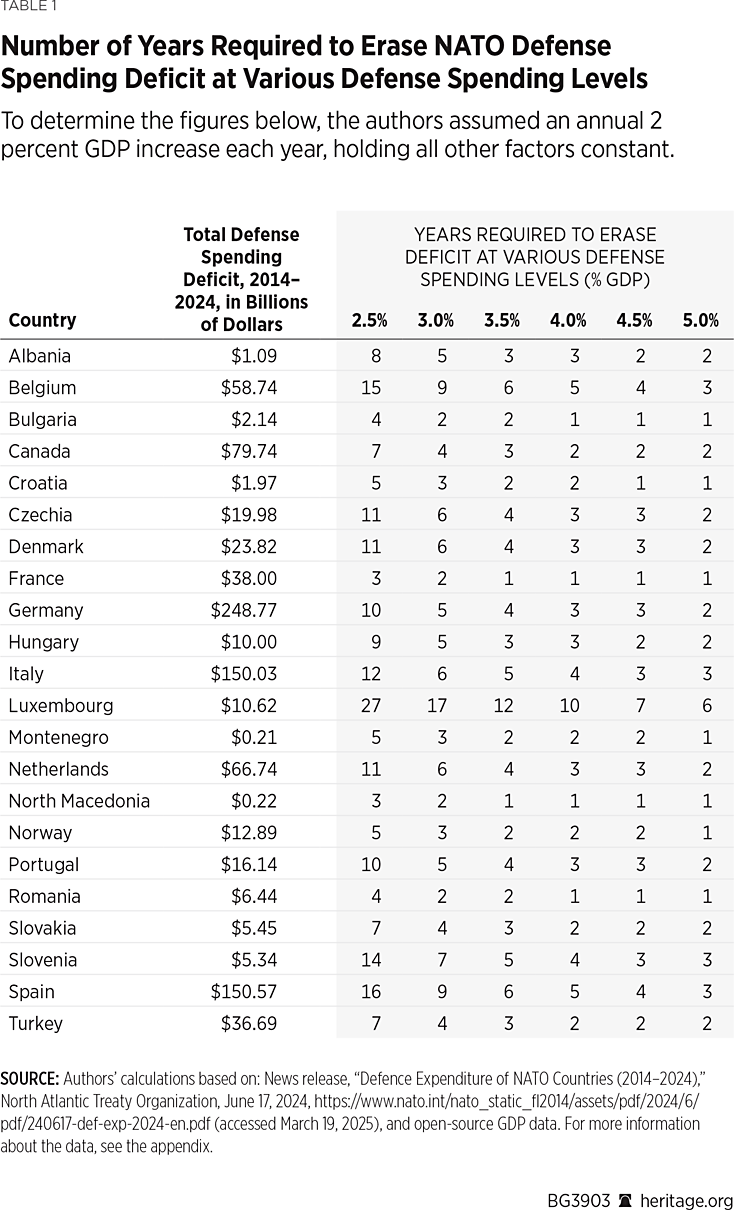
Assuming a constant, real GDP growth of 2 percent, NATO members still require several years to compensate for a decade of underfunding, even when spending more than 2 percent of GDP. Table 1 outlines the timeline for different spending scenarios.
- If spending 2.5 percent of GDP, most NATO members will need until 2035 to make up for their spending shortfalls.
- If spending 3 percent of GDP, some NATO members could make up their shortfalls by 2030.
- If spending 3.5 percent of GDP, almost all NATO members would fully make up for their shortfalls by 2030.
- If spending 4 percent of GDP, the Alliance could credibly achieve its Article 3 commitments of self-defense by 2030 and achieve the level of deterrence outlined in the 2014 Wales Declaration.
Encouragingly, members are taking actions to raise defense spending. On the Eastern Flank, Poland,REF Estonia, Latvia,REF and LithuaniaREF are moving toward 5 percent while Denmark works to bring defense spending to above 3 percent.REF Germany has also announced prospective measures to durably increase their defense spending moving forward.REF Additionally, Alliance leaders, including NATO Secretary General Mark Rutte,REF U.K. Prime Minister Keir Starmer,REF and Germany’s Chancellor-Apparent Friedrich MerzREF have acknowledged the need to spend more. Further, Germany has led European contributions to UkraineREF while the United Kingdom,REF Sweden,REF and NorwayREF have made positive Ukraine-support announcements, as other partners finalize structured pathways for new support.
Recommendations for NATO and Its Members
In order to ensure collective defense, NATO should:
- Reset NATO spending targets to at least 3 percent. Great power aggression has returned to the European continent, and only credible capabilities backed by significant defense expenditures will deter it. With a net deficit among America’s NATO allies of more than $800 billion, NATO spending targets and national follow-through must rapidly increase to 3 percent or more.
- Reinforce Article 3. Confronting the creaking state of the transatlantic defense industrial base, NATO members should reinforce Article 3 of the North Atlantic Treaty. This includes rebuilding force structures, increasing military readiness, and concentrating resources on military mobility infrastructure at the same time as making weapons system purchases to ensure that the security build-up does not become a paper tiger isolated from the front lines of a future conflict.
European NATO members should:
- Take the lead as Ukraine’s primary supporters. President Donald Trump, Vice President JD Vance, Secretary of Defense Pete Hegseth, Secretary of State Marco Rubio, and Special Envoy to Ukraine Keith Kellogg have all made clear that European NATO members must take the lead in supporting Ukraine as the United States devotes resources to stabilization and deterrence in other theaters where NATO is not a relevant player—chiefly in the Indo–Pacific. To achieve this objective, a commitment to sustained defense spending and force readiness is required.
Conclusion
It is time to reframe the debate on NATO defense spending from an aspirational goal to a long-overdue course correction to a decade of underinvestment. The reality is that most NATO members have systematically underfunded their militaries. This has hollowed out European defense capabilities, exposing the continent to external threats and instability.
For more than a decade, many NATO countries have prioritized welfare expansion over defense procurement, a miscalculation that directly contributed to Europe’s current security crisis.REF Russia’s 2014 annexation of Crimea should have been a wake-up call; instead, it was met with half-measures and delayed commitments from key allies. The consequences of this complacency became undeniable in 2022, when Moscow launched its full-scale invasion of Ukraine, shattering any remaining illusions about European security.
Increased defense spending is neither a new nor arbitrary target. NATO’s collective security is only as strong as each member’s willingness to invest in it. The debate should not be about whether spending should rise—it must rise, not as a future aspiration, but as a belated correction for years of strategic neglect.
Miles Pollard is an Economic Policy Analyst in the Center for Data Analysis at The Heritage Foundation. Jordan Embree is a Research Associate in the Margaret Thatcher Center for Freedom at The Heritage Foundation. The authors would like to thank Kyle Mendelson of the spring 2025 Young Leaders Program for his excellent data collection assistance for the charts and tables.
Appendix: Notes on NATO Data
- Equipment expenditures include spending on research and development (R&D).
- Total military spending includes pensions paid to military retirees.
- Total military spending also accounts for portions of non-military forces that could realistically be deployed internationally during wartime.
- Data presented in the NATO report were sourced in June 2024; figures provided for 2023 and 2024 are estimates.
- All financial data is reported in 2024 dollars using 2024 exchange rates. Therefore, numbers for specific years and aggregated totals may differ from other assessments.
- Finland, Montenegro, North Macedonia, and Sweden joined NATO after 2014; inclusion of these nations in figures varies depending on the specific data presented.
- Figures often exclude the United States, whose significantly larger scale can distort comparative analysis and may not be relevant to the intended focus of the graphic.
- Iceland is excluded from figures because it does not maintain a standing military force.





